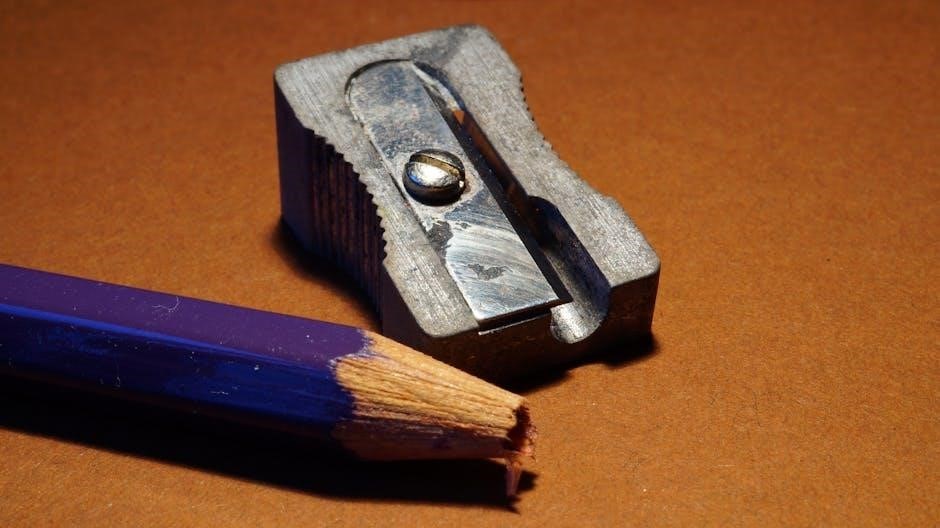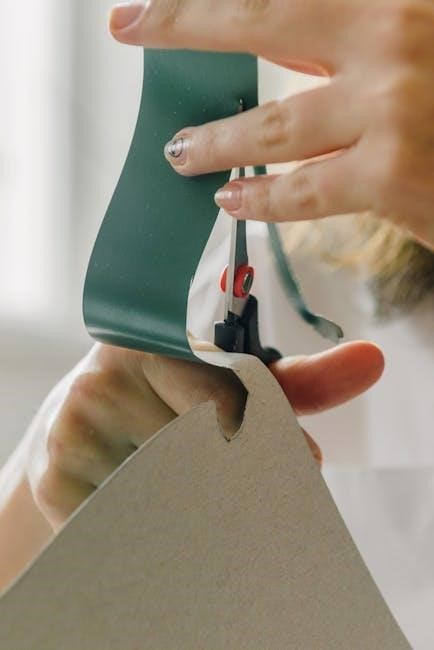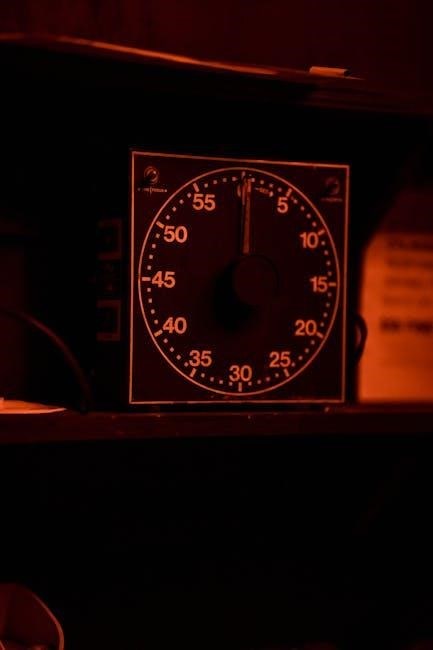Sharp atomic clocks leverage radio signals from NIST’s WWVB station to maintain accuracy. These clocks automatically synchronize, providing precise timekeeping. The technology relies on atomic oscillations for unparalleled precision.
Brief Overview of Atomic Clock Technology
Atomic clocks, including those manufactured by Sharp, use radio-controlled signals to maintain exceptional time accuracy. These clocks receive signals, often from the WWVB radio station, which broadcasts time codes derived from atomic standards. By decoding these signals, Sharp atomic clocks automatically adjust to the correct time, ensuring precision within one second. This eliminates the need for manual adjustments and guarantees reliable timekeeping. The clock synchronizes to the WWVB signal and once the radio signal is decoded, the hands will automatically adjust to the correct time.
Importance of Accurate Timekeeping
Accurate timekeeping is crucial for various aspects of daily life and professional activities. Sharp atomic clocks ensure precise scheduling, synchronization of events, and reliable record-keeping. In industries such as transportation, finance, and telecommunications, even slight time discrepancies can lead to significant errors. Sharp atomic clocks provide the reliability needed for critical applications by synchronizing to radio signals. Maintaining correct time also helps with personal organization, punctuality, and overall efficiency, making these clocks valuable in homes and offices.
Setting Up Your Sharp Atomic Clock
To begin, install fresh batteries, typically AA, into your Sharp atomic clock. Observe the correct polarity. The clock will then attempt to synchronize with the WWVB signal automatically.
Initial Setup and Battery Installation
The initial setup of your Sharp atomic clock begins with installing the correct type and number of batteries, typically AA batteries. Ensure that you insert the batteries according to the polarity markings inside the battery compartment. Once the batteries are installed, the clock will power on and automatically attempt to synchronize with the WWVB radio signal. Allow several minutes for the clock to start searching for the signal for synchronization. The hands move to find WWVB signal.
Time Zone Selection
Selecting the correct time zone is crucial for accurate timekeeping. Locate the time zone selector, typically found on the back of your Sharp atomic clock. Use this selector to choose your specific time zone. Available options often include Pacific, Mountain, Central, and Eastern. Ensure the switch corresponds to your location for correct synchronization. After selecting your time zone, the clock will adjust automatically once it receives the WWVB signal. If you are out of reach, set manually.

Manual Time Setting
To manually set your Sharp atomic clock, press and hold the SET button for three seconds. This activates manual mode, allowing you to adjust the time and calendar if needed, especially when the radio signal is weak.
Accessing Manual Setting Mode
To initiate manual time setting on your Sharp atomic clock, locate the “SET” button. Press and hold this button for approximately three seconds. This action will trigger the clock to enter manual setting mode. The display should then indicate that you are in manual adjustment mode, allowing you to modify the time, date, and other settings. This is useful when the atomic signal cannot be received.
Adjusting Time and Calendar Manually
Once in manual setting mode, use the adjustment buttons (often labeled “+” and “-“) to modify the hours, minutes, year, month, and day. Press the “SET” button again to cycle through these setting options. Ensure you select the correct AM/PM setting. After setting the date, press the SET button to confirm the changes; Once completed, the clock will save your settings. This feature helps maintain accuracy when WWVB signal reception is unavailable.
Understanding Radio Signal Reception
Sharp atomic clocks receive time data from the WWVB radio transmitter. The clock’s internal antenna captures this signal, decoding the time and date information. This process ensures accurate synchronization.
How Atomic Clocks Receive WWVB Signal
Sharp atomic clocks utilize a built-in antenna to capture the low-frequency radio waves emitted by the WWVB transmitter in Fort Collins, Colorado. This transmitter broadcasts a time code derived from atomic clocks, ensuring accuracy to within a fraction of a second. The clock decodes this signal, synchronizing its internal time with the atomic standard. Optimal reception usually occurs during nighttime hours when atmospheric interference is minimal. Signal strength can be affected by location and obstructions.
Troubleshooting Signal Reception Issues
If your Sharp atomic clock struggles to receive the WWVB signal, try repositioning it near a window or away from electronic devices that might cause interference. Ensure the clock is not obstructed by metal objects. Initiate a manual signal search by pressing and holding the “REC” or “Wave” button. If problems persist, check the battery level, as a weak battery can hinder reception. Consider testing the clock in a different location to rule out local interference issues.

Alarm Functionality
To set the alarm on your Sharp atomic clock, press and hold the “Alarm Set” button. Use the “+” and “-” buttons to adjust the hour and minute. Confirm your settings by pressing “Alarm Set” again.
Setting and Adjusting Alarm Time
To initiate alarm setting, press and hold the “Alarm Set” button for approximately two seconds until the alarm time display flashes. Subsequently, use the “+” or “-” buttons to increment or decrement the desired hour. After setting the hour, press the “Alarm Set” button again to proceed to setting the minutes. Similarly, utilize the “+” or “-” buttons to adjust the minutes. Once the desired alarm time is configured, press the “Alarm Set” button one final time to confirm and save the alarm settings. The alarm icon should appear on the display to indicate that the alarm is active.
Using Snooze Function
When the alarm sounds, pressing the “Snooze” button will temporarily silence the alarm for a short interval, typically around five to ten minutes. The snooze function allows for a few extra minutes of rest without completely disabling the alarm. After the snooze period elapses, the alarm will sound again. This cycle can usually be repeated several times. To completely turn off the alarm, press the “Alarm Off” button or the designated button for deactivating the alarm function.

Daylight Saving Time
Sharp atomic clocks automatically adjust for Daylight Saving Time (DST) due to the WWVB signal. The clock receives updates and shifts the time accordingly, eliminating manual adjustments for DST transitions.
Automatic DST Updates
Sharp atomic clocks are designed for convenience, featuring automatic Daylight Saving Time (DST) updates. These clocks constantly monitor the WWVB signal, which broadcasts the current time and DST status. When DST begins or ends, the clock automatically adjusts the time forward or backward by one hour. This eliminates the need for manual intervention, ensuring your clock is always accurate, even during DST transitions. This feature provides seamless timekeeping and ease of use.
Manual Adjustment for DST (If Needed)
While Sharp atomic clocks are designed for automatic DST updates, manual adjustment might be necessary in certain situations. If the clock fails to receive the WWVB signal or if DST rules change, you may need to adjust the time manually. To do so, access the manual setting mode by pressing and holding the SET button. Then, follow the instructions to advance the time forward or backward by one hour to align with the current DST setting. This ensures continued accuracy.
Troubleshooting Common Issues
If your Sharp atomic clock isn’t receiving the WWVB signal, relocate it near a window. Ensure the clock is away from electronic interference. Try resetting the clock and initiating a manual signal search.
Clock Not Receiving Signal
When a Sharp atomic clock fails to receive the WWVB signal, several factors could be at play. First, ensure the clock is positioned near a window or an external wall to maximize signal strength. Radio interference from electronics like TVs or computers can disrupt reception. Try moving the clock away from these devices. A weak battery can also impede signal acquisition, so replace the batteries with fresh ones. Initiate a manual signal search by pressing and holding the appropriate button; refer to your clock’s manual. If issues persist, consider testing the clock in a different location.
Display Problems
Experiencing display issues on your Sharp atomic clock can be frustrating. If the display is dim or unreadable, the first step is to replace the batteries with a new set. Low battery power is a common cause. Ensure the batteries are correctly installed, matching the polarity markings. If the display is still faint, try adjusting the contrast or brightness settings, if available. For a completely blank display, double-check the power source and battery connections. If the problem persists, the display module itself may be faulty, and professional repair or replacement might be necessary.

Care and Maintenance
Proper care ensures longevity. Regularly replace batteries per guidelines to avoid corrosion. Clean the clock with a soft, dry cloth, avoiding liquids. Store in a cool, dry place when not in use.
Battery Replacement Guidelines
To ensure continuous and accurate operation of your Sharp atomic clock, it is crucial to adhere to proper battery replacement guidelines. Always use fresh, high-quality AA batteries as recommended in the manual. When replacing, ensure correct polarity (+/-) alignment. Remove old batteries promptly to prevent potential leakage and corrosion, which can damage the clock’s internal components. If the clock will not be used for an extended period, remove the batteries entirely. This practice prolongs the lifespan of your device and maintains optimal performance.
Cleaning and Storage
Proper cleaning and storage are essential for maintaining your Sharp atomic clock. To clean, gently wipe the clock with a soft, dry cloth. Avoid using harsh chemicals, abrasive cleaners, or excessive moisture, as these can damage the display and internal components. When storing the clock for extended periods, remove the batteries to prevent corrosion. Store it in a cool, dry place away from direct sunlight and extreme temperatures. This will help preserve its functionality and appearance for years to come. Ensure it is kept in a safe location to avoid accidental damage.
Advanced Features
Some Sharp atomic clocks offer advanced features like dual alarms, allowing you to set two separate wake-up times. Explore models with color displays for enhanced visibility and information at a glance.
Dual Alarm Clocks
Many Sharp atomic clocks come equipped with a dual alarm function, providing added convenience for users with varied schedules. This feature enables setting two independent alarm times, ideal for couples or individuals needing separate weekday and weekend alarms. To set, access the alarm settings and configure each alarm individually, ensuring the correct AM/PM setting. Some models offer customizable alarm sounds for a personalized wake-up experience. Make sure to properly engage and disengage the alarms as needed to avoid unwanted wake-ups.
Color Display Features
Select Sharp atomic clocks boast vibrant color displays, enhancing readability and adding a touch of modernity. These displays often present information such as time, date, indoor temperature, and alarm settings in a visually appealing format. Users can typically adjust the display’s brightness for comfortable viewing in various lighting conditions. Some models even offer customizable color themes, allowing users to personalize the display to their preferences. The color display enhances the user experience, making information easily accessible at a glance.
